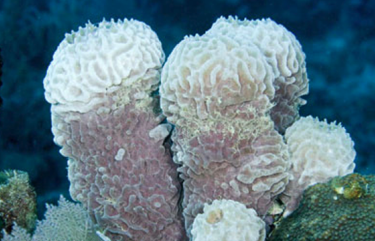
Our oceans are amazingly full of life. The underwater world has plants, animals, fish, and so much more clustering around living cities called coral reefs. These underwater reefs are the most biologically diverse areas on our planet. Coral polyps are the architects of underwater cities! Polyps secrete hard exoskeletons to support and protect their bodies, laying layers of limestone over layers of limestone. Their underwater architecture creates living habitats for sponges, anemones, plants, seaweed, snails, crustaceans, mollusks, sea snakes, and fish. Corals are tiny animals of the group cnidaria (silent “c”). Other cnidarians include hydras, jellyfish, and sea anemones. Corals do not move but affix themselves in a place and accumulate other corals in a colony that acts as a single organism or coral reef. Corals live in colonies entirely of individual polyps. Often called the ‘rain forests’ of the seas, the underwater architecture of coral reefs is home to 25% of all marine species. Some coral colonies are over hundreds and thousands of years, and some even millions of years old!
Activity 1 – protect the coral reefs

Coral Reefs provide essential habitats for about 25% of all ocean species! These ecosystems, sometimes called the “rainforests of the sea,” are full of life. Coral reefs are susceptible to water temperature and pollution changes, so we must protect them. What can you do to protect our coral reefs? Earth’s underwater cities, however, are under attack. Water pollution, overfishing, human development and rising sea temperatures from climate change are changing the life of these important plants and animals. As the levels of carbon dioxide (CO2) rise in the atmosphere, CO2 levels rise in our oceans. Higher CO2 decreases the PH level, causing our oceans to become more acidic. Search the Internet for groups focused on protecting coral reefs. Pick a group that you can join and volunteer. Apply what you learned in the previous activities to volunteer with a group and promote awareness of coral reef protection by writing a short paper.
Activity 2 – Underwater Cities

Coral Polyps are underwater architects. These underwater architects belong to the phylum or group that is radially symmetrical, meaning they are the same all the way around. Polyps have a central sac with a hole in one end surrounded by stinging tentacles. Coral reefs are rich underwater habitats full of many different species. They are home to as many living things as the world’s rainforests. Coral reefs have a symbiotic relationship with the species inhabiting them; both need each other to survive. Using clay and other hard and soft sculpting materials, build a 3-dimensional coral reef with at least ten species of fish, crustaceans, plants, and animals.
Activity 3 – be a coral reef architect

There are three types of coral reefs, Barrier reefs, fringing reefs, and atools. Barrier reefs are away from the shore. Fringing reefs are in shallow shoreline waters. Reefs that encircle a lagoon are called atolls. Sea animals (Cnidaria) such as hydras, jellyfish, and sea anemones inhabit the limestone exoskeletons built by the underwater architect Polyps. Coral reefs provide food and medicine, protect coasts from waves and storms, help prevent sea level rise, and generate tourism. They are protectors of our shorelines. Underwater reefs, however, are declining due to water pollution, overfishing, human development, and rising sea temperatures from climate change.
Activity 4 – gifts of coral reefs

Earth’s underwater cities, however, are under attack. Water pollution, overfishing, human development, and rising sea temperatures from climate change are changing the lives of these important plants and animals. As carbon dioxide (CO2) levels rise in the atmosphere, so do the CO2 levels in our oceans. Higher CO2 decreases the pH level, and our oceans become more acidic. Search the Internet for groups focused on protecting coral reefs. Pick a group that you can join and volunteer. Apply what you learned in the previous activities to volunteer with a group and promote awareness of coral reef protection.
Activity 5 – Underwater Architects

Coral Polyps are underwater architects. These underwater architects belong to the phylum or group that are radially symmetric which means that they are the same all the way around from a central point. Polyps have a central sac with a hole in one end surrounded by stinging tentacles. Jellyfish are cnidaria. Research the world’s major coral reefs. Print a world map and locate and label the reef locations. For each reef you labeled on your world map, find out what plants, animals, and sea life inhabit each reef. Make watercolor drawings of three different reefs showing the color, beauty, and diversity of life in underwater cities. Be sure to include both plants and animals.
Review

- Corals are
- Underwater architects of coral reefs are
- Coral reefs are home to ___% of marine life.
- Coral reefs located offshore are known as
- CO2 levels in the ocean _______________PH levels.
Explore
- Allen Coral Atlas
- Beautiful Math of Coral Reefs, TED Talk Margaret Wertheim
- Conserving our spectacular, vulnerable coral reefs - TED Lessons by Joshua Drew
- Coral Reef Games
- Coral Reef Simulation National Geographic
- Coral Reef Simulation Whyville
- Ecology 180: This is Coral Video
- EPA Coral Reef Protection
- IMAX Coral Reef Trailer
- National Geographic Coral Reefs
- Nature Conservancy Adopt a Coral Reef
- Securing Long Term Futures for Coral Reefs
- Smithsonian Coral Gardens of the Deep Sea
- Take a Coral Reef Scuba Dive Adventure
- TEDed Video Crocheting the Coral Reef Conuncrum with Climate Change
- Video MPM The Great Barrier Reef


















































